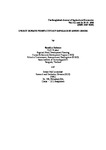Energy demand perspectives in Bangladesh, (1992/93 – 2019/20)
| dc.contributor.author | Rahman, Sanzidur | |
| dc.date.accessioned | 2014-03-14T12:53:52Z | |
| dc.date.accessioned | 2014-03-14T12:54:10Z | |
| dc.date.available | 2014-03-14T12:53:52Z | |
| dc.date.available | 2014-03-14T12:54:10Z | |
| dc.date.issued | 1998-06 | |
| dc.identifier.issn | 0257-3539 | |
| dc.identifier.uri | http://hdl.handle.net/10026.1/2907 | |
| dc.description.abstract |
The present paper attempted to forecast the demand for primary energy broadly categorized into: (a) commercial (coal, petroleum, natural gas, and hydropower), and (b) non-commercial energy (rice hull and straw, jute stick, firewoods, crop wastes, etc.) for the period 1992/93-2019/20 AD to facilitate in the energy sector planning and development. The demand forecast, based on past time series data (1972/73-1991/92), is made by utilizing two methods: (a) "Market Penetration Theory" that uses trend extrapolation and inter-fuel substitution priniciples, and (b) "Trend Extrapolation Model" taking into account the the exogenous variables, e.g., GDP and energy/GDP ratio. Results reveal that the fractional share of commercial energy in total energy consumption will increase from the 1991/92 level of 51 percent to 85 percent by 2019/20 AD. The total energy demand for 2019/20 AD, by using the "Market Penetration" model, is estimated at 1,465 Peta Joules. The share of commercial and non-commercial energy constitutes 1,239 and 226 Peta Joules, respectively. The annual compound growth rates for total energy, commercial energy and non-commercial energy for the period 1992/93-2019/20 AD, are estimated at 3.23%, 4.89% and - 0.01%, respectively. This implies that, the commercial energy demand would increase by a factor of four from the 1991/92 consumption level of 300 Peta Joules, while the demand for noncommercial energy being substituted by the commercial energy over time would decrease slightly instead. Within the commercial energy sector, the demand for natural gas would dramatically increase by a factor of six from the 1991/92 consumption level of 206 to 1,202 Peta Joules by 2019/20 AD thereby covering 97 percent of total commercial energy demand. Therefore, special attention is required to plan for the commercial energy sector as it relates to direct depletion of a non-renewable natural resource stock, i.e., the natural gas. The energy demand forecasts made by utilizing the "Trend Extrapolation" model also yielded a close estimate of total energy demand of 1,655 Peta Joules by 2019/20 AD (a 12 percent variation from the estimate of "Market Penetration" model). | |
| dc.format.extent | 39-57 | |
| dc.language.iso | en | |
| dc.relation.replaces | http://hdl.handle.net/10026.1/2906 | |
| dc.relation.replaces | 10026.1/2906 | |
| dc.title | Energy demand perspectives in Bangladesh, (1992/93 – 2019/20) | |
| dc.type | journal-article | |
| dc.type | Article | |
| plymouth.issue | 1&2 | |
| plymouth.volume | 21 | |
| plymouth.publication-status | Published | |
| plymouth.journal | Bangladesh Journal of Agricultural Economics | |
| plymouth.organisational-group | /Plymouth | |
| plymouth.organisational-group | /Plymouth/Faculty of Arts, Humanities and Business | |
| plymouth.organisational-group | /Plymouth/Users by role | |
| dcterms.dateAccepted | 1998-01-01 | |
| dc.rights.embargoperiod | Not known | |
| rioxxterms.licenseref.uri | http://www.rioxx.net/licenses/all-rights-reserved | |
| rioxxterms.type | Journal Article/Review |


